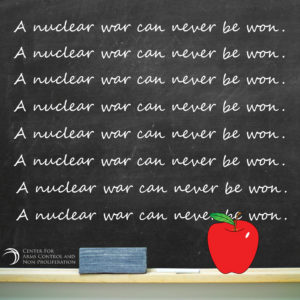By Anna Schumann
 It’s back-to-school season, and while it may be the kids who are going to class, adults nationwide will also need to brush up on their spelling, long division and science fair skills. While everyone loves a good baking soda volcano, there are potential real-life explosions that we should all be worried about. In fact, it’s time for the whole country to do a quick refresher on nuclear weapons — after all, you help pay for them.
It’s back-to-school season, and while it may be the kids who are going to class, adults nationwide will also need to brush up on their spelling, long division and science fair skills. While everyone loves a good baking soda volcano, there are potential real-life explosions that we should all be worried about. In fact, it’s time for the whole country to do a quick refresher on nuclear weapons — after all, you help pay for them.
Here are five things you should know:
- There are still a lot of nuclear weapons in the world. As much as we might want to believe it, the nuclear threat did not end with the Cold War. Nine countries have a total of more than 14,000 nuclear weapons worldwide: China, France, India, Israel, North Korea, Pakistan, Russia, the United Kingdom and the United States. More than 90% of them belong to the United States and Russia, who have more than 6,000 each.
- Reducing nuclear weapons stockpiles is possible. Thanks to the hard work of diplomats, technical experts and activists, the global nuclear stockpile has been greatly reduced from its peak of about 70,000 during the Cold War. Every President since Kennedy — until now — has worked to reduce nuclear arsenals in some capacity, by signing treaties like Ronald Reagan’s Intermediate-Range Nuclear Forces (INF) Treaty and Barack Obama’s New Strategic Arms Reduction Treaty (New START). Unfortunately, the Trump Administration has withdrawn from agreements that were helping prevent nuclear proliferation and a new nuclear arms race. New START is now the only treaty restricting the U.S. and Russian nuclear arsenals, and the Trump Administration has said it might not extend it past its expiration in 2021.
- The President alone decides when to use a nuclear weapon. The President can order a nuclear strike, even if the United States or its allies have not been attacked with nuclear weapons, and there is no check or balance on that power. (A No First Use policy, which we strongly support, would prevent the President from starting a nuclear war.) Right now, in essence, the United States has a thermonuclear monarchy.
- The United States spends a lot of money on nukes. Over the next 30 years, the United States is set to spend roughly $1.7 trillion — with a T — on modernizing existing nuclear weapons systems, and that number will only go up. In fact, it doesn’t even include the new nuclear capabilities the Trump Administration has requested.
- You can help reduce the nuclear threat. We know nuclear weapons policy can seem terrifying and, frankly, overwhelming. But ordinary citizens are not helpless. You can educate yourself on nuclear issues the way you do on health care, education, immigration and other issues that matter to you. You can ask your elected officials where they stand on issues like No First Use, defense spending and nuclear diplomacy. You can urge your local schools to mention nuclear weapons issues more than in the context of Hiroshima and Nagasaki. You can talk about these issues with your friends. And, finally, you can follow and support our work.
As American kids get back to school, we need all Americans to get back into the nuclear conversation. Together, we can reduce nuclear threats.
